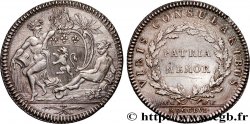E-auction 115-62064 - fjt_078883 - LYONNAIS - CONSULATE OF LYON Jeton bronze argenté 30, les quatre échevins 1721
You must signin and be an approved bidder to bid, LOGIN TO BID. Accounts are subject to approval and the approval process takes place within 48 hours. Do not wait until the day a sale closes to register. Clicking on « bid » constitutes acceptance of the terms of use of cgb.fr private e-auctions.
Bids must be placed in whole Euro amounts only. The sale will start closing at the time stated on the item description; any bids received at the site after the closing time will not be executed. Transmission times may vary and bids could be rejected if you wait until the last second. For further information ckeck the E-auctions F.A.Q.
NO BUYER'S FEE.
NO BUYER'S FEE.
| Estimate : | 45 € |
| Price : | 17 € |
| Maximum bid : | 21 € |
| End of the sale : | 29 June 2015 18:26:00 |
| bidders : | 5 bidders |
Type : Jeton bronze argenté 30, les quatre échevins
Date: 1721
Metal : silver plated bronze
Diameter : 30 mm
Orientation dies : 6 h.
Weight : 9,38 g.
Edge : lisse
Coments on the condition:
Bel exemplaire qui a été argenté. L’usure est surtout visible sur les reliefs où l’argenture manque
Catalogue references :
Obverse
Obverse legend : MESSIEVRS. BOVRG. ESTIENNE. MICHON. MICHEL ECN. D. LYON.
Obverse description : Écussons aux armes des quatre échevins, posés deux et deux et accompagnés de cimiers et lambrequins, au-dessous 1721.
Reverse
Reverse description : Écusson ovale aux armes de la Ville, placé sur un cartouche que soutient une console et qui a pour tenants les figures allégoriques nues et debout du Rhône et de la Saône laissant échapper l’eau de leurs urnes.
Commentary
Cet exemplaire a été anciennement argenté.








 Report a mistake
Report a mistake Print the page
Print the page Share my selection
Share my selection Ask a question
Ask a question Consign / sell
Consign / sell
 Full data
Full data








